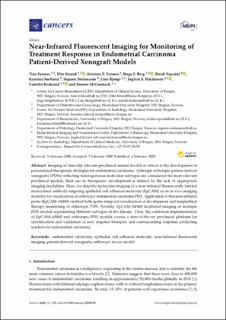| dc.contributor.author | Fonnes, Tina | |
| dc.contributor.author | Strand, Elin | |
| dc.contributor.author | Fasmer, Kristine Eldevik | |
| dc.contributor.author | Berg, Hege Fredriksen | |
| dc.contributor.author | Espedal, Heidi | |
| dc.contributor.author | Sortland, Kristina | |
| dc.contributor.author | Stefansson, Ingunn | |
| dc.contributor.author | Bjørge, Line | |
| dc.contributor.author | Haldorsen, Ingfrid S. | |
| dc.contributor.author | Krakstad, Camilla | |
| dc.contributor.author | Mc Cormack, Emmet | |
| dc.date.accessioned | 2021-02-26T13:15:41Z | |
| dc.date.available | 2021-02-26T13:15:41Z | |
| dc.date.created | 2020-02-13T14:44:05Z | |
| dc.date.issued | 2020 | |
| dc.identifier.issn | 2072-6694 | |
| dc.identifier.uri | https://hdl.handle.net/11250/2730696 | |
| dc.description.abstract | Imaging of clinically relevant preclinical animal models is critical to the development of personalized therapeutic strategies for endometrial carcinoma. Although orthotopic patient-derived xenografts (PDXs) reflecting heterogeneous molecular subtypes are considered the most relevant preclinical models, their use in therapeutic development is limited by the lack of appropriate imaging modalities. Here, we describe molecular imaging of a near-infrared fluorescently labeled monoclonal antibody targeting epithelial cell adhesion molecule (EpCAM) as an in vivo imaging modality for visualization of orthotopic endometrial carcinoma PDX. Application of this near-infrared probe (EpCAM-AF680) enabled both spatio-temporal visualization of development and longitudinal therapy monitoring of orthotopic PDX. Notably, EpCAM-AF680 facilitated imaging of multiple PDX models representing different subtypes of the disease. Thus, the combined implementation of EpCAM-AF680 and orthotopic PDX models creates a state-of-the-art preclinical platform for identification and validation of new targeted therapies and corresponding response predicting markers for endometrial carcinoma. | en_US |
| dc.language.iso | eng | en_US |
| dc.publisher | MDPI | en_US |
| dc.rights | Navngivelse 4.0 Internasjonal | * |
| dc.rights.uri | http://creativecommons.org/licenses/by/4.0/deed.no | * |
| dc.title | Near-Infrared Fluorescent Imaging for Monitoring of Treatment Response in Endometrial Carcinoma Patient-Derived Xenograft Models. | en_US |
| dc.type | Journal article | en_US |
| dc.type | Peer reviewed | en_US |
| dc.description.version | publishedVersion | en_US |
| dc.rights.holder | Copyright 2020 by the authors. | en_US |
| dc.source.articlenumber | 370 | en_US |
| cristin.ispublished | true | |
| cristin.fulltext | original | |
| cristin.qualitycode | 1 | |
| dc.identifier.doi | 10.3390/cancers12020370 | |
| dc.identifier.cristin | 1793921 | |
| dc.source.journal | Cancers | en_US |
| dc.source.40 | 12(2) | |
| dc.identifier.citation | Cancers. 2020, 12 (2), 370 | en_US |
| dc.source.volume | 12 | en_US |
| dc.source.issue | 2 | en_US |

